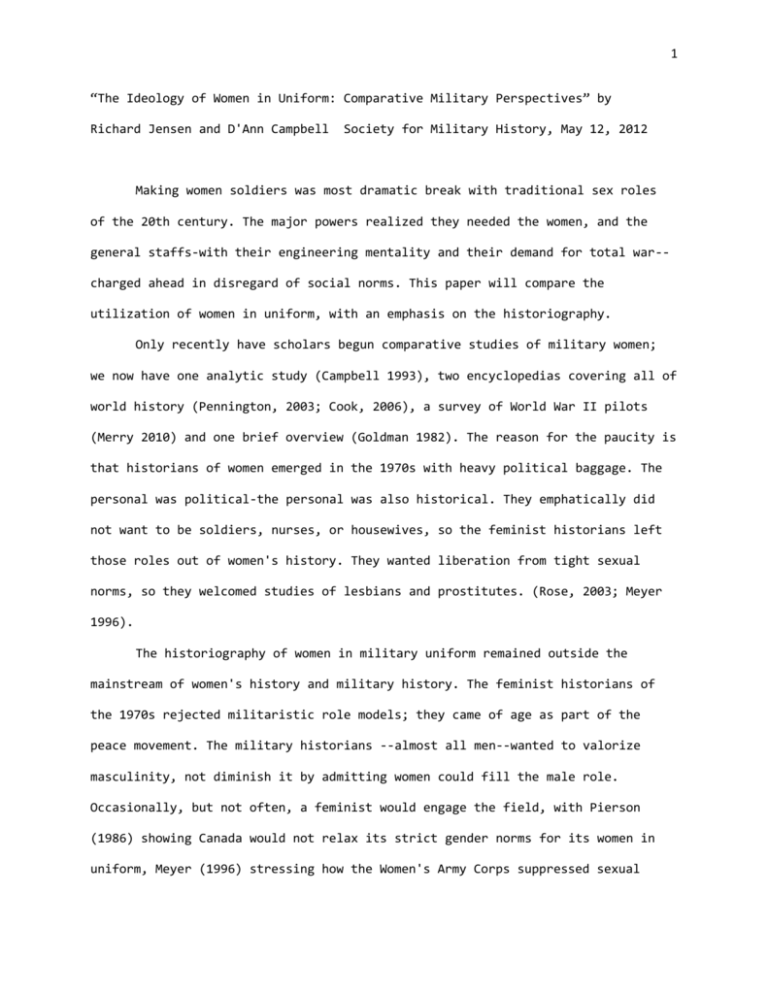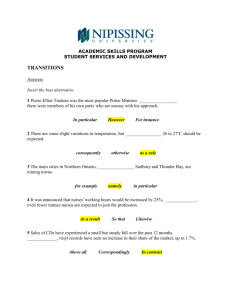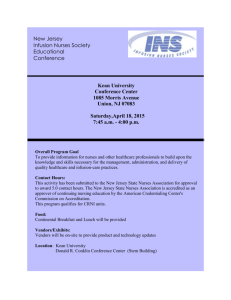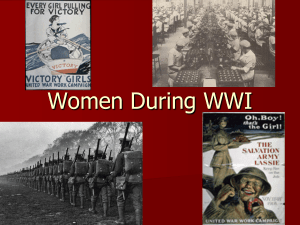“The Ideology of Women in Uniform: Comparative Military
advertisement

1 “The Ideology of Women in Uniform: Comparative Military Perspectives” by Richard Jensen and D'Ann Campbell Society for Military History, May 12, 2012 Making women soldiers was most dramatic break with traditional sex roles of the 20th century. The major powers realized they needed the women, and the general staffs-with their engineering mentality and their demand for total war-charged ahead in disregard of social norms. This paper will compare the utilization of women in uniform, with an emphasis on the historiography. Only recently have scholars begun comparative studies of military women; we now have one analytic study (Campbell 1993), two encyclopedias covering all of world history (Pennington, 2003; Cook, 2006), a survey of World War II pilots (Merry 2010) and one brief overview (Goldman 1982). The reason for the paucity is that historians of women emerged in the 1970s with heavy political baggage. The personal was political-the personal was also historical. They emphatically did not want to be soldiers, nurses, or housewives, so the feminist historians left those roles out of women's history. They wanted liberation from tight sexual norms, so they welcomed studies of lesbians and prostitutes. (Rose, 2003; Meyer 1996). The historiography of women in military uniform remained outside the mainstream of women's history and military history. The feminist historians of the 1970s rejected militaristic role models; they came of age as part of the peace movement. The military historians --almost all men--wanted to valorize masculinity, not diminish it by admitting women could fill the male role. Occasionally, but not often, a feminist would engage the field, with Pierson (1986) showing Canada would not relax its strict gender norms for its women in uniform, Meyer (1996) stressing how the Women's Army Corps suppressed sexual 2 freedom, and Krylova (2010) showing that young Russian women could use Communist ideals of the new Soviet to break away from bourgeois gender roles. Utilization of women was an obvious solution to shortages of manpower, but it was the British Army which had done the planning and were first to use them. The British model for the use of women in uniform was copied by Canada and the Commonwealth nations, as well as by the United States. Women were volunteers in military service, as was the case in all countries except Russia. Only one nation, Finland, successfully integrated its women in uniform into the broader civilian woman's movement. That was possible because the Latta movement in Finland was a well-organized interwar effort to move women into socially necessary volunteer jobs, to which non-combat military roles were added. Women released men to fight was a priority not so much for the generals as for the politicians, who thought it would be a winning propaganda technique to encourage women to volunteer. The strategy backfired, for women released the men to go into deadly combat; the women did not want their husbands, brothers, boyfriends, and fiancés taken off desk jobs and sent into combat units. Much more effective was the propaganda argument that women could bring their men home sooner if they themselves were in uniform. Above all, there was patriotism, or as Ovetta Culp Hobby told the first WAACs, they had a date with destiny and were repaying a debt to democracy. Public opinion polls showed a 50-50 split on whether women should be in uniform, with support declining during the war. (Torres-Reyna and Shapiro, 2002) While the British had good planning, as well as an upper-class and royal patronage, the Americans played catch-up. There was no support network in high society, politics, or the women's organizations that provided a recruiting network, a support system, or even people willing to speak up among their friends 3 and neighbors about the value of women in the military. While numerous male movie stars, top athletes, and head coaches joined the armed forces with a flash of publicity, there were no high visibility celebrities in any of the women's services. New York's fashion industry was not consulted when it came to uniform design, except in the case of the Navy, which therefore had the sharpest outfits, with the WAC consigned to drab masculine-like uniforms with mediocre cut, tailoring, and material quality. The directors were young society women or college presidents with no knowledge of the military and few connections in Washington. Nevertheless, the military found the right women leaders and they all turned in a credible performance. (Godson, 2002) Washington planned a much smaller operation than the British were running, expecting 12,000 women in the Army in 1942 in a peak of 25,000 in 1944. Officers were trained at an old cavalry fort in Des Moines, Iowa. A surprising surge of applications rolled in, producing its exaggerated estimates of the supply, and the generals demanded more and more--suggesting an unlimited demand. There was talk of 1.5 million women in the Army. The engineering orientation of the generals required for maximum utilization of manpower, for technology and for industrial capacity to engage in total warfare. The amount of paperwork needed was enormous, ranging from personnel files, orders, repair manuals, vouchers, payroll slips, requisitions, medical records, and any number of other documents that had to be dictated, type, copied, delivered, responded to, and filed away -jobs that were increasingly handled by women in advanced industrial societies. The United States was the world leader in the use and the employment of women in clerical jobs on the home front. It was also a leader in military paperwork, with 35% of the soldiers in the Army assigned to clerical work in 1944. (Campbell, 1984). The generals thought they could ask and be given the women. The 4 prevailing view was that the media could manipulate public opinion and produce results, especially since countervailing criticism could not be published or voiced on the radio. Massive recruiting campaigns were launched to enlist women but few stepped forward. The media, it turned out, could not manipulate women to do what they did not want to do. (Treadwell, 1954) The main problem was that the men in uniform did not want to allow women in uniform. The men repeatedly warned their womenfolk at home NOT to join the services because it would damage their reputations. While the military was harsh on gay men, it largely ignored lesbians. Most women never had heard the term; a WAC investigation of eleven bases turned up four active couples. (Weatherford, 2009; Berube, 1990). However, the WAC--and many civilians--focused on the dangers of masculinized women. The American policy was to strongly discourage any sexual activity during service-there was no hint of sexual liberation in the WAC. (Meyer, 1996). The ugly rumors that circulated about Wacs focused on heterosexual promiscuity and pregnancy, not lesbianism. These were false charges circulated by men who resented the idea of losing their non-combat jobs when women arrived. The rumors were widely repeated by male soldiers who warned their sisters and girlfriends away from the services. Recruiting fell off and never recovered. (Treadwell, 1954). In all the American services, a total of 340,000 women served, in addition to the nurses. (Campbell, 1984). In 1938, the British took the lead worldwide in establishing uniformed services for women, in addition to the small nurses units that had long been in operation. In late 1941, Britain began conscripting women, sending most into factory work and some into the military, especially the Auxiliary Territorial Service (ATS), attached to the army. It began as a woman's auxiliary to the military in 1938, and in 1941 was granted military status (with 2/3 pay compared 5 to men). Women had a well-publicized role in handling anti-aircraft guns against German planes and V-1 missiles. The daughter of Prime Minister Winston Churchill was there, and he gushed that any general who saved him 40,000 fighting men had gained the equivalent of a victory. By August, 1941, women were operating the fire-control instruments; they were never allowed to pull the trigger, as killing the enemy was too masculine. (DeGroot 1997) . By 1943, 56,000 women were in AA Command, most in units close to London where there was a risk of getting killed, but no risk of getting captured by the enemy. The first "kill" came in April, 1942, when the commanding general noted, "Beyond a little natural excitement and a tendency to chatter when there was a lull, they behaved like a veteran party, and shot an enemy plane into the sea." (Campbell, 1993; Schwarzkopf, 2009). General Dwight Eisenhower suggested the Americans use women in antiaircraft units, so Chief of Staff George Marshall authorized a secret experiment that compared all-male units with 50-50 mixed units. The latter had higher performance scores, for women "are superior to men" in handling the instrumentation and doing repetitious jobs. The anti-aircraft generals called for 2400 women. (Treadwell, 1945) Marshall refused-American public opinion was not ready for women in combat so he shut down the experiment and clamped a lid of secrecy on it. America had drawn the gender line. (Campbell, 1993) Public opinion mattered little in Berlin, and as the Allied bombs started falling, the Germans put more and more of their resources into anti-aircraft units. The Germans shifted upwards of a fourth of their economy into antiaircraft protection, using hundreds of thousands of women in Luftwaffe uniform to shoot down Allied bombers. (Hagemann 2011; Biddiscombe, 2011) Combat crews were up to half female and they shot down thousands of Allied airmen. By 1945, 450,000 German women had volunteered for the auxiliaries, in addition to the nurses. By 6 1945, German women were holding 85% of the billets as clericals, accountants, interpreters, laboratory workers, and administrative workers, together with half of the clerical and junior administrative posts in high-level field headquarters. (Campbell 1993; Williamson, 2003) In Australia, the civilian government, not the generals, made the decisions. The civilians were committed to the Australian ideal of male mateship and male military roles and were therefore hostile to women in uniform. Australia was the one country where elite civilian women played a decisive role. They organized volunteers and at their own expense, trained them in radio signals and telegraphy. The Air Force, by far the most socially aware unit, grew rapidly and had an urgent need for telegraph operators. Hundreds of women were available but the Cabinet insisted it look for men. Few could be found. Reluctantly, the Cabinet allowed a few hundred women on a limited-time experiment until men were available. Then the Navy wanted women telegraphers. After the prime minister witnessed the success of the ATS in Britain, the Cabinet finally went along. (Hasluck, 1952). In the event, 65,000 Australian women volunteered for service in the war, 27,000 in the Women's Auxiliary Australian Air Forces (WAAAF), 24,000 in the Australian Women's Army Service (AWAS), and 3000 in the Women's Royal Australian Naval Service (WRANS). They performed a variety of back-office services, but they also operated Searchlight units. The units were closed at the end of the war but revived in 1950. (Pennington, 2003) Russia was Hitler's number-one target and everyone could see the urgency, especially after hundreds of thousands of men were lost in the first months of battle in 1941. By 1945 over 800,000 Soviet women saw active service, with 120,000 assigned to combat units. They dominated the medical and nursing units, and were combat pilots, navigators, snipers, anti-aircraft, as well as laborers 7 in field bath/laundry units, and cooks. They were radio operators, truck drivers, and political commissars who enforced party discipline. (Cottam, 1980; Erikson, 1990; Krylova, 2010; Pennington, 2010) After three more years of very high casualties among its men, Moscow turned more and more to women. All-female elite units were formed using volunteers from the 300,000 women in the Young Communist League (Komsomol), including 50,000 in nursing units, and many in anti-aircraft units. Komsomol women formed three bomber regiments, and the Central Female Sniper School trained over a thousand snipers and over four hundred sniper instructors for men's units. Komsomol women dreamed of becoming the new Soviet woman who had overthrown bourgeois conceits about women's pacifistic nature and reached a new stage of equality with men that could be proven in combat. In practice, women had few command position, (Krylova, 2010). Soviet historians ignored their achievement although state propaganda focused on the heroic dimension of personal relationships, home, and the mother and motherland, in an expression of humanistic values, to inspire self-sacrifice. The masculine ideal became the soldier risking his life to defend his family, while the ideal woman was either a war worker or a "rodina-mat" ("motherland-mother") who sent her children to the front and awaited their letters. (Kirschenbaum, 2000) After the war the memories of Russian women veterans were channeled along patriotic and masculine lines approved by the partyit became their patriotic “sacred duty” to stand back and allow the male veterans to step forward as the heroes of the war. The flood of women’s memoirs under Brezhnev followed a standardized model in which women testified to the achievements of the collective and downplayed any individuality. Markwick explores how historians can reconstruct the underlying narrative. (Markwick, 2008) 8 In India, the Women's Auxiliary Corps operated 1939 to 1947, with peak strength of 850 officers and 7,200 auxiliaries in the Indian army, and including a small naval section formed for the Royal Indian Navy. (Harfield, 2005). The Rani of Jhansi Regiment was the Women's Regiment of the Indian National Army; active 1943-45, it fought against the British as part of the pro-Japanese Indian National Army of Subhas Chandra Bose. He mobilized models of women as mothers and sisters rooted in Indian mythology and tradition, and portrayed the direct involvement of women as necessary for the pursuit of nationalist goals. Drawing on rich, malleable Indian lore, he articulated a modern definition of female heroism considerably in advance of the more passive concepts of Mahatma Gandhi. His was a losing cause that left no impact on India. (Lebra, 2008; Hills and Silverman, 1993). Other belligerents had a mixed record regarding women in combat. The Free French Women's Auxiliary Army operated in North Africa from 1943 to 1944 with 3,100 women who worked mainly as wireless and telephone operatives, drivers, secretaries, interpreters, nurses, and social assistants. (Gaujac, 2000; Dominé, 2008). Mussolini had refused to allow women in his army. However, in 1944, the rump Mussolini regime formed the Servizio Ausiliario Femminile. Fascist women, although not carrying arms, were mobilized alongside men in the civil war. (De Grazia, 1992). In Finland the Lotta organization had build a nationwide woman's network between the wars to promote volunteer social service work. Lotta included 242,000 women, out of a national population of fewer than four million. The Lottas worked in hospitals, at air-raid warning posts, and other auxiliary tasks in conjunction with the armed forces, and they were officially unarmed. The only 9 exception was a voluntary anti-aircraft searchlight battery in Helsinki in the summer of 1944, composed of Lotta Svärd members. (Cook, 2006) By far the most celebrated women of World War II were the 2000 pilots who worked flew warplanes for Britain, Germany, the Soviet Union and the United States (Merry, 2010). In the U.S., 1100 women ferried airplanes from factories to embarkation points. The Women's Air Force Service Pilots (WASPS), under the leadership of high society pilot Jacqueline Cochran, merged with the Women's Auxiliary Ferrying Squadron (WAFS) in 1943. The original justification was a shortage of male pilots. When that shortage was gone in 1944, the WASP was disbanded. Cochran's goal was to glamorize women who could handle a high visibility, high performance male role. However, post war America had few aviation roles for them apart from airline stewardess. (Merryman, 1997). The Soviets made the most extensive use of women aviators after Marina Raskova convinced Stalin to let Komsomol form three all-female regiments. In all, the "Night Witches" flew 30,000 combat sorties; two pilots became fighter aces and 30 were named Heroes of the Soviet Union. (Pennington, 2007) The story of women in uniform had a policy dimension, but gap between the history profession and the Pentagon planners was too wide to bridge. The presidential commission on women in combat called on theologians and pollsters, but not historians. (United States Presidential Commission on the Assignment of Women,1993). Feminism paid a heavy price -the Equal Rights Amendment was lost chiefly because traditionalists emphasized it meant drafting women, and the feminists did not want that to happen because of their hostility to all military roles. Of central importance in raising the status of women in Europe was their role in resistance movements. (Strobl, 2007) Resistance leaders generally 10 assigned women traditional support roles, and gave them duties in hiding, supplying, and communicating with underground units. Rarely were women admitted to the underground combat units. Nursing represented a major role for women worldwide, and since the days of Florence Nightingale had been an accepted role for women in wartime. In the United States the military wanted well-trained efficient specialists. All the services used enlisted men to handle the routine care of sick patients are wounded patients, and use their nurses as officers who were trained specialists. In military units, male doctors supervised female nurses, and both were officers, while the women in practice supervised large numbers of enlisted men. Army and Navy nursing was highly attractive and a larger proportion of nurses volunteered for service higher than any other occupation in American society. The nation responded by a dramatic increase in the numbers and functions of nurses, and a moderate modest increase in their pay scales, with the expansion powered by the training of 200,000 nurses' aides by the Red Cross, and the creation of a temporary new government agency, the Cadet Nurse Corps, which enrolled 170,000 young women in speeded up training programs in the nation's 1200 nursing schools. (Campbell, 1984; Sarnecky, 1999). American nurses were kept out of harm's way, with the great majority stationed on the home front. However 77 were stationed in the jungles of the Pacific, where their uniform consisted of "khaki slacks, mud, shirts, mud, field shoes, mud, and fatigues." (Campbell, 1984; Norman, 1999). The 20,000 nurses in Europe were safely behind the lines as they worked in evacuation hospitals, primarily in the role of supervising the male enlisted medics. The closer to the front, the more flexible and autonomous was the nurse's role. The women wanted to be much closer to the front, but they had too weak a voice to counter the 11 Pentagon's highly protective attitude. (Campbell, 1984). The new leaders emerging from the war had learned command skills, maneuvering in complex bureaucracies, the taste of equal pay an officer status, and autonomy within military medical system. New technical skills validated their demands for an autonomy as they learned and employed in crisis situations the latest trauma and medical techniques and technologies. When the nurses returned home they used the previously powerless American Nurses Association to take control of the nursing profession. (Campbell, 1984; Sarnecky, 1999). Nursing was not a major military focus for the other Allies. For example, in Britain, only 10,500 nurses enrolled in Queen Alexandra's Imperial Military Nursing Service (QAIMNS) and the Princess Mary's Royal Air Force Nursing Service. These services dated to 1902 and 1918, and enjoyed royal sponsorship. There also were VAD nurses who had been enrolled by the Red Cross, (McBryde, 1985). In Canada, however, Toman, 2007 has provided a deep understanding of the multiple roles of Canadian nurses as they negotiated their way through military, professional and personal goals. Unlike Britain, Germany had a very large and well organized nursing service, with four main organizations, one for Catholics, one for Protestants, the secular DRK (Red Cross) and the "Brown Nurses," for committed Nazi women. Military nursing was primarily handled by the DRK, which came under partial Nazi control. Frontline medical services were provided by male medics and doctors. Red Cross nurses served widely within the military medical services, staffing the hospitals that perforce were close to the front lines and at risk of bombing attacks. Two dozen were awarded the iron Cross for heroism under fire. They are among the 470,000 German women who served with the military. (Williamson 2003). 12 The brief historiography focuses on the dilemmas of Brown Nurses forced to look the other way while their patients were murdered. (McFarland-Icke, 1999). Brazil operated a small nursing program with a strong ideological goal. Brazil sent 73 nurses to Italy as part of the Força Expedicionária Brasileira (FEB) and the Brazilian Air Force (FAB). The Vargas regime heavily publicized the nurses in terms of its "Estado Novo" ("new state"), and affirmed nursing as a suitable profession for middle-class women. Furthermore they exemplified a devotion to the motherland as they delivered maternal care to the soldiers in combat, helping make the war a collective experience that would bring together all Brazilians. Nationalism thus helped transcend gender and class restrictions. (Cytrynowicz, 2000). In conclusion we can formulate some generalizations. First, there was a remarkable similarity in the roles women played in all the major nations. Only a few (Japan, China) refused to set up women's services. One can see a spillover effect of an intense national ideology in the case of Germany and Russia, but even there the practical organization of women was handled by career male soldiers who were not especially political. Second, women in uniform was not the product of feminism, and did not create or inspire long-term feminist goals among the women who served. Homefront women's organizations did not spring up or remodel themselves in response. The women's services were designed as temporary-and were temporary--for two reasons. The women who saw an urgent immediate patriotic need for their services did not fell this need trumped the long-term roles they sought in society in terms of family and motherhood. Third, one group of career women was exceptional--the nurses, especially in the U.S. They immediately saw the war as an opportunity to become independent of male forces (such as the Red Cross) and create an independent nursing association. Fourth, 13 there is one other group of women--the pilots--who saw themselves not so much as career aviators but as independents who would assert their new freedom in the air. Significantly, they refused to be merged into the WAC or the Air Force. There was a second reason for being temporary: the men did not want women soldiers. Most men did not want them in uniform during the war, and with one exception, they did not women around permanently. The one exception was the generals and admirals. They were engineers with a career code based on military values and efficiency that they deemed superior to an independent of civilian values. Women played very useful roles in wartime, especially in societies which ran out of manpower, such as Britain and Russia. 14 Bibliography Berube, Alla. (1990). Coming Out Under Fire: The History of Gay Men and Women in World War. Biddiscombe, Perry, (2011). "Into the Maelstrom: German Women in Combat, 194445," War & Society, (March 2011), Vol. 30 Issue 1, p61-89 Campbell , D'Ann. (1984). Women at War with America: Private Lives in a Patriotic Era. Campbell, D'Ann. (1990). "Servicewomen of World War II", Armed Forces and Society 16, 251-70. Campbell, D'Ann. (1993). "Women in Combat: The World War Two Experience in the United States, Great Britain, Germany, and the Soviet Union", Journal of Military History 57 (April), 301-323 Cook, Bernard, ed, (2006). Women and War: Historical Encyclopedia from Antiquity to the Present. Cottam, K. Jean. (1980). "Soviet Women in Combat in World War Ii: The Ground Forces and the Navy," International Journal of Women's Studies, 3, no 4, 345-357. Cottam, K. Jean. (1982). "Soviet Women in Combat in World War II: The Rear Services, Resistance behind Enemy Lines and Military Political Workers," International Journal of Women's Studies, 5 no 4, 363-378 Cytrynowicz, Roney, (2000). "A Serviço aa Patria: A Mobilização aas Enfermeiras no Brasil Durante a Segunda Guerra Mundial", Historia, Ciencias, Saude Manguinhos, 7, no 1, 73-91. DeGroot, G.J. (1997). "Whose Finger on the Trigger? Mixed Anti-Aircraft Batteries and the Female Combat Taboo" War in History, Dec 1997, Vol. 4 Issue 4, p434-453 De Grazia, Victoria. (1992). How Fascism Ruled Women: Italy 1922-1945 15 Dominé, Jean-François, (2008). Les femmes au combat ; l'arme féminine de la France pendant la Seconde Guerre Mondiale Erickson, John. (1990). "Night Witches Snipers and Laundresses" History Today, 40, no 7 (July) 29-35. Gaujac, Paul, (2000). "Des Corps Feminins aux Afat: Afrique du Nord 1943-1944", Guerres Mondiales et Conflits Contemporains, 50, no 198 (April), 109-122. Godson, Susan H, (2002). Serving Proudly: A History of Women in the U.S. Navy. Goldman, Nancy Loring ed. (1982). Female Soldiers--Combatants or Noncombatants? Historical and Contemporary Perspectives. Hagemann, Karen, (2011). "Mobilizing Women for War: The History, Historiography, and Memory of German Women’s War Service in the Two World Wars," Journal of Military History 75:3 (2011): 1055-1093 *Hancock, W.K. and M. Gowing. (1949). British War Economy. London: H.M. Stationery Office. Harfield, Alan, (2005). "The Women's Auxiliary Corps (India)", Journal of the Society for Army Historical Research 83, no 335 (Autumn), 243-254. Hasluck, Paul. (1952). The Government and the People: 1939-1941. Canberra: Australian War Memorial. Hills, Carol and Daniel C. Silverman. (1993). "Nationalism and Feminism in Late Colonial India: The Rani of Jhansi Regiment", Modern Asian Studies, 27, no 4 (July), 741-760. Kirschenbaum, Lisa A. (2000). "'Our City, Our Hearths, Our Families': Local Loyalties and Private Life in Soviet World War II" Slavic Review, Winter 2000, Vol. 59 Issue 4, pp 825-47 Krylova, Anna, (2010). Soviet Women in Combat: A History of Violence on the Eastern Front. 16 Lebra, Joyce C, (2008). Women Against the Raj: The Rani of Jhansi Regiment. Singapore: Institute of Southeast Asian Studies. McBryde, Brenda. (1985). Quiet Heroines: Story of the Nurses of the Second World War McFarland-Icke, Bronwyn Rebekah. (1999). Nurses in Nazi Germany. Markwick, Roger D. (2008). "A Sacred Duty": Red Army Women Veterans Remembering the Great Fatherland War, 1941-1945," Australian Journal of Politics & History, (2008), 54#3 pp. 403-420. Merry, Lois K, (2010). Women Military Pilots of World War II: A History with Biographies of American, British, Russian and German Aviators. Merryman, Molly. (1997). Clipped Wings: The Rise and Fall of the Women Airforce Service Pilots of World War II. Meyer, Leisa D . (1996). Creating GI Jane; Sexuality and Power in the Women's Army Corps during World War II. Norman, Elizabeth. (1999). We Band of Angels: The Untold Story of American Nurses Trapped on Bataan by the Japanese. Pennington, Reina, (2003). Amazons to Fighter Pilots: A Biographical Dictionary of Military Women. Pennington, Reina, (2007). Wings, Women & War: Soviet Airwomen in World War II Combat. Pennington, Reina, (2010). "Offensive Women: Women in Combat in the Red Army in the Second World War" Journal of Military History, July 2010, Vol. 74 Issue 3, p775-820 Pierson, Ruth Roach. (1986). They're Still Women After All: The Second World War and Canadian Womanhood. 17 Rose, Sonya O, (2004). Which People's War?: National Identity and Citizenship in Wartime Britain 1939-1945 Sarnecky, Mary T. (1999). A History of the U.S. Army Nurse Corps. Schwarzkopf, Jutta, (2009). "Combatant or Non-Combatant? The Ambiguous Status of Women in British Anti-Aircraft Batteries during the Second World War." War & Society, Vol. 28 Issue 2, pp 105-131 Seidler, Franz. (1979). ''Blitzmädchen - Hilf siegen - Die Geschichte der Helferinnen der deutschen Wehrmacht'' Toman, Cynthia, (2007). An Officer and a Lady:Canadian Military Nursing and the Second World War. Torres-Reyna, Oscar and Robert Y. Shapiro. (2002). "Women and Sexual Orientation in the Military," Public Opinion Quarterly, (Winter 2002), Vol. 66 Issue 4, pp 618-632 Treadwell, Mattie E. (1954).. United States Army in World War II: Special Studies: The Women's Army Corps. Washington; U.S. Army *United States Presidential Commission on the Assignment of Women. (1993). Weatherford, Doris, (2009). American Women during World War II: An Encyclopedia Williamson, Gordon, (2003). World War II German Women's Auxiliary Services. --end--








